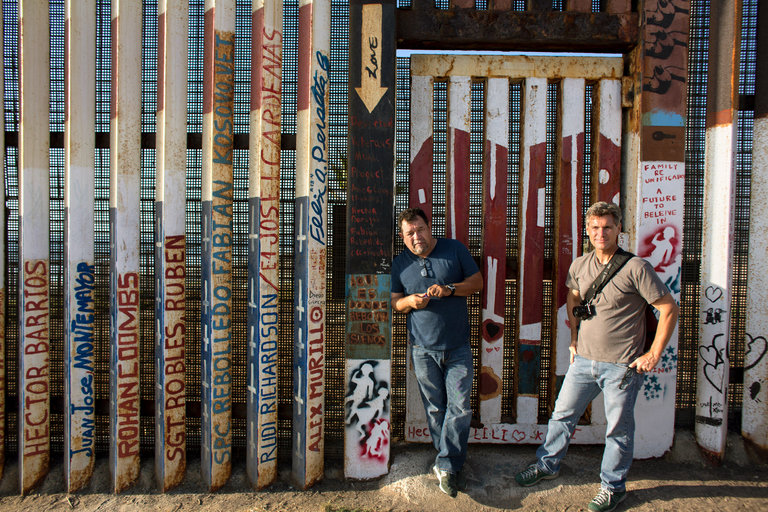Marcos Ramírez, the ebullient artist known as ERRE, recently drove from San Diego to his workshop studio in Tijuana in a black Chevy Suburban riddled with bullet holes. The vehicle had a starring role in “La Suburban Negra,” or “The Black Suburban,” his 2012 installation and video about the drug trade, in which he plays a drug lord, a hit man and a cop.
“The police, the bad guys, the C.I.A., the soccer moms — everybody with authority has a black Suburban,” he explained as he barreled down Interstate 5 toward the border, making a slight detour for a strawberry ice cream cone.
For young men growing up in Tijuana, as Mr. Ramírez did, the three characters he portrays in “The Black Suburban” are potential life choices. He eventually opted for a fourth path: as a Conceptual artist whose work grapples with “the frictions produced by human interactions” in the dual worlds on either side of the United States border with Mexico.
Even amid calls by Donald J. Trump, the Republican presidential nominee, for building a wall at that border, the art scene in the San Diego-Tijuana megalopolis has assumed a consciously and exuberantly binational ethos.
The Museum of Contemporary Art San Diego, a mere 17 miles from the Western Hemisphere’s busiest land border crossing, has been at the forefront of collecting and exhibiting the work of Tijuana-based artists. The museum’s leadership views the proximity to the border as a “sweet spot” that helps lure younger audiences, said Hugh M. Davies, the museum’s director.
Mr. Ramírez, an internationally recognized artist whose work has appeared at the Whitney Biennial, made headlines in 1997 by installing a 33-foot-high two-headed Trojan horse in the fume-choked highway median on the American side of the border crossing. He is a ringleader of an increasingly visible fraternity of artists — Mr. Davies calls them “the straddlers” — who ricochet back and forth across “la linea,” as the border is colloquially known.
Since the 1980s, the Contemporary Art Museum has hosted, or collaborated on, a series of groundbreaking border-centric exhibitions. These include InSite, a phalanx of installations scattered around San Diego and Tijuana over the years, and the museum’s 2007 “Strange New World: Art and Design From Tijuana,” a sweeping view of that city’s creative ferment, featuring the work of 41 artists. That show ranged from Julio César Morales’s digitally exploding pushcarts, a symbol of the city’s informal economy, to engravings by Jaime Ruiz Otis, made from beat-up polyurethane mats scavenged from the large manufacturing plants known as maquiladoras.
To reach his studio in the Colonia Libertad section, where he grew up, Mr. Ramírez leaves the relatively somnolent streets of downtown San Diego for a city of 1.3 million, where it’s not uncommon to encounter fire jugglers, Michael Jackson impersonators or teetering clowns on stilts at traffic stops.
Resonantly, perhaps, Mr. Ramírez has received a commission from the United States General Services Administration to create a work for the expanded Port of Entry in San Ysidro, Calif., the busiest border crossing.
Two years ago, this 55-year-old artist’s preoccupation with the border reached something of a crescendo when he and the photographer David Taylor, 51, a University of Arizona art professor, set out on a 3,700-mile buddy trip to fabricate and install 47 sheet metal obelisks along the old, unmarked 1821 boundary between Mexico and the western territories of the United States, a border that existed only in treaties.
The result, financed by a binational clutch of museums, is “Delimitations,” a photography and video exhibition now on view at the museum in San Diego, with a smaller version being presented at the Mexican Cultural Institute in Washington.
Their pilgrimage began in Brookings, Ore., where the two artists, accompanied by a filmmaker, José Inerzia, traipsed through sand and fog to plant the first obelisk on a windswept beach. For the Mexican-born Mr. Ramírez, the treaty that severed Mexico from over half its territorial lands represented a wound. “It was a wound with no scar,” he explained. “So we acknowledged the loss by making a scar for the wound” — with the location of each obelisk mapped on Google Earth.
Mr. Taylor was game for the project after spending seven years photographing the 276 cast-iron and stone monuments, now lonely, that defined the present-day border before the fence was built. Many are in desolate wilderness areas that required Indiana Jones-style derring-do to locate. “We talk about the border as this monolithic phenomenon,” he observed. “But it’s a series of places with unique identities.”
In contrast to more venerable Mexican cities, Tijuana is a relative newbie “whose identity is still under construction,” according to Pedro Ochoa, the director of the Tijuana Cultural Center. The grisly drug violence that peaked in 2011 nearly paralyzed the city’s freewheeling artistic spirit. “The difficult times left artists without collectors,” said Aida Valencia, a gallery owner who moved her business to San Diego.
Since then, grass-roots artists have been busy reclaiming their city. In 2012 the Contemporary Art Museum began offering art and food field trips to Tijuana, led by its education curator, Cristina Szorca, a Tijuanero. The vibrancy the visitors witnessed reflects the idea of “one integrated metropolis,” said Michael Dear, an emeritus professor of city and regional planning at the University of California, Berkeley.
The Getty Foundation recently began a $15 million initiative called “Pacific Standard Time: LA/LA” that focuses on Latin American and Latino art, with a significant nod to the United States-Mexican border. The program links curators in multiple countries and is funding 50 museum exhibitions across Southern California. “A lot of younger artists are taking on the physical reality and imagination of the border as a subject,” said Joan Weinstein, the foundation’s deputy director.
Among them are Misael Diaz, 29, and Amy Sanchez, 28, who live in Santa Ana, Calif., but are frequently encamped in Tijuana, where they combine Conceptual art with social activism. As the Cog·nate Collective, the two staged a conference about border issues from their elaborately painted ’87 Chevy Cavalier and broadcast it to northbound drivers stopped dead in border traffic. At a nearby artisans’ market, they set up residencies for indigenous artists. They also created the ultimate drive-in along the highway by renting a billboard and showing border-related movies (with free popcorn) to frustrated motorists waiting in line.
In a nondescript Tijuana building painted with a red heart, the 44-year-old artist Alida Cervantes explores the stratification of Mexican society. On a recent morning, her studio brimmed with paintings of voluptuous women in classical attire, inspired by glittery Oaxacan folk ceramics.
Ms. Cervantes, who was born into affluence in Tijuana, grew up with the notion that it “was just dust, gas stations and prostitutes, and not a real cultural place,” she said. Now her hometown fortifies her.
She lives in San Diego but commutes daily to Tijuana. She views the border as a metaphor for “collisions, for things that aren’t meant to be together put together.”
“I’m addicted to both worlds,” she said. “It’s like having a boyfriend on the side.”





